Today’s CometWatch entry is a mosaic of four NAVCAM images obtained last Wednesday, 8 April, from an average distance of 137 km from the centre of Comet 67P/Churyumov-Gerasimenko. The image resolution is 11.7 m/pixel and the individual 1024 x 1024 frames measure about 12 km across. The mosaic has been slightly cropped, and it measures 9.3 x 9.3 km.
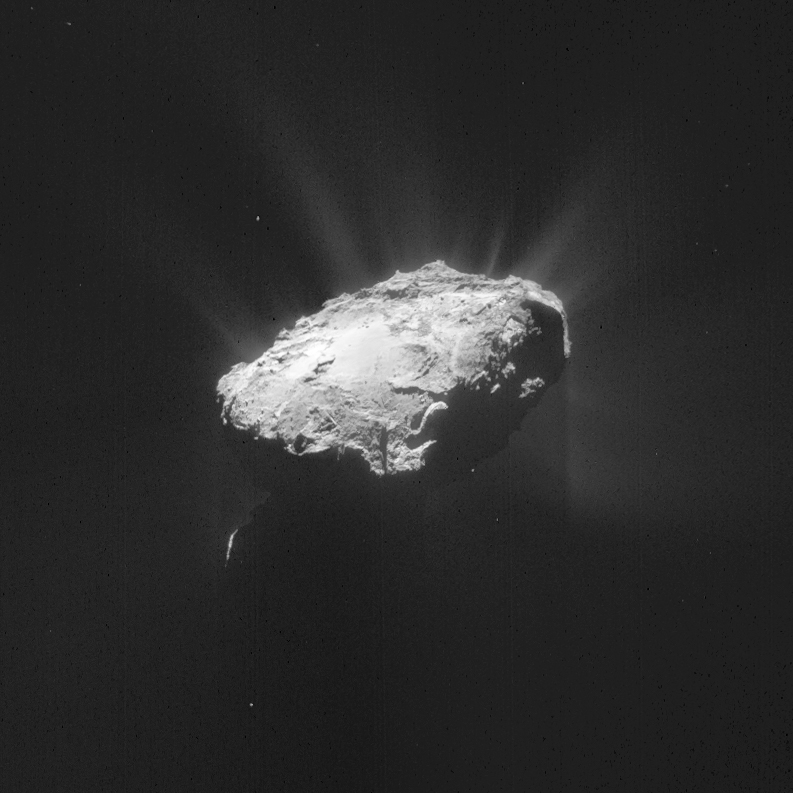
Four image mosaic of images taken by Rosetta’s NAVCAM from a distance of 137 km from the comet centre. Rotation and translation of the comet during the imaging sequence make it difficult to create an accurate mosaic, and there may be some spurious spatial and intensity features as a result of the mosaic-making process, so always refer to the individual frames before performing any detailed comparison or drawing conclusions about any strange structures or low intensity extended emission. The mosaic has been cropped and processed in Lightroom to bring out the comet’s activity. Credits: ESA/Rosetta/NAVCAM – CC BY-SA IGO 3.0
As explained in an earlier post today, Rosetta has been performing a series of manoeuvres in the past couple of weeks to correct its trajectory, reaching the target distance of 140 km on 8 April. These NAVCAM images were taken about eight hours after that.
The view shows the ‘underside’ of the comet large lobe, revealing the smooth Imhotep region, which is covered in dust and boulders but also exhibits circular pits and other interesting surface features.
The image has been processed in Lightroom to bring out the comet’s overall activity, and the bulk of the comet nucleus can be seen as a dark silhouette against the diffuse ‘atmosphere’ of 67P/C-G, below the illuminated portion of surface. A glint of the small comet lobe is also visible in the lower left part of the image.
A four image montage of the original frames and the individual 1024 x 1024 pixel images are provided below:

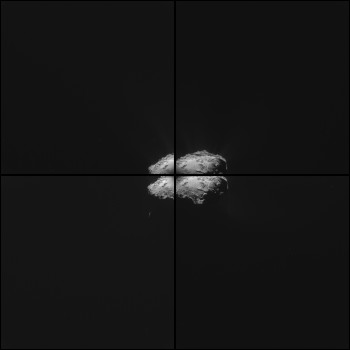
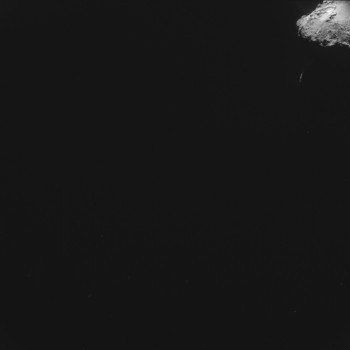
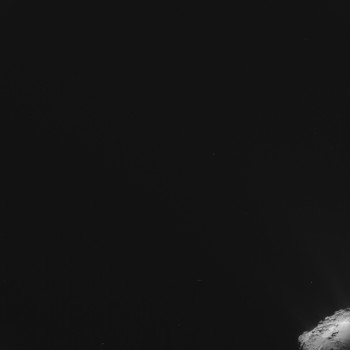
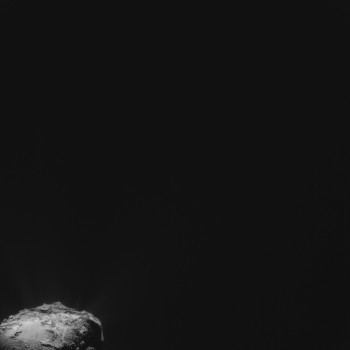
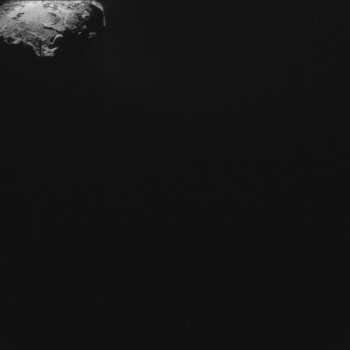








Discussion: 9 comments
“…there may be some spurious spatial and intensity features as a result of the mosaic-making process, so always refer to the individual frames before performing any detailed comparison or drawing conclusions about any strange structures or low intensity extended emission.”
Good luck with that, Claudia!
Excellent images, as always.
My take on this mosaic:
https://www.flickr.com/photos/105035663@N07/16914875400/in/photostream/
And with levels adjusted to show jets and the shadow of the largest lobe on the coma:
https://www.flickr.com/photos/105035663@N07/16482308713/in/photostream/
Bottom centre of the sunlit part there is a white linear feature which may be a surface feature or, more interestingly, a jet which seems to be rather well-collimated. Can someone with sharper eyes comment?
Kamal
It’s really only one pixel wide (apparently two where it lies at the diagonal corner of two.)
More likely a single reflective object in motion seen against the background of the terrain? We have seen such ‘streaks’ against the black background of space a few times before.
The original would tell us, JPG effects dont help.
Incidentally this shot again shows the striking ‘straight line in space’ effect that caused controversy a while back. (Dropping vertically from the right hand edge of 67P.) This time I think it’s much more obviously an effect of shadowing & perspective.
Harvey: Yes, I think you are right, it should be one small moving chunk. But it does look like it is shot out from the surface, doesn’t it? (I know, it could all be perspective.)
Yes it does.
But I just happened to look again, not zooming in quite so far.
Its odd, at the bottom right of this short track, I percieve a new straight track at almost exactly 90 degrees heading left and down to the black edge. There is then a short bright curved edge bordering black space low & left & a black lump up & right. And then at a very bright pixel a new straight diagonal track heading up & right which almost joins the feature you originally mentioned to form a a slightly wedged rectangle with a bit of a gap in it.
This may just be one of those odd things its easy to percieve in pixellated images, though I did show the picture to a (one!) ‘naif observer’ & say ‘see anything?@ & they immediately picked it out.
Its obviously the landing guidance system for an alien spacecraft 🙂
Harvey: A slightly different angle in the April 12 picture.
Harvey: From the EGU poster 12877 by Vincent et al: Jets are seen at all scales, down to the resolution of the OSIRIS images. The smallest features detected so far are a few pixels across, which translates into a couple of meters at most. They have a typical column density a few percent higher than the ambient medium. At the highest spatial resolution these jets appear as a combination of thinner features which can be traced directly to specific morphologic features on the surface.
Retry, failed.
I wouldn’t exclude a jet. But I think the fact that it remains one pixel wide for the full track length favours a particle explanation.
The original, uncompressed image might make it clear.